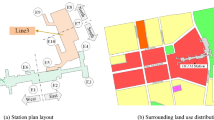Abstract
In this research, we introduce a modified TASEP model with a bottleneck in order to model visitors’ behavior in a crowded aquarium, Kaiyukan in Japan, and to propose a congestion reduction method. It is distinct in that visitors walk through a fixed one-way aisle, as opposed to a typical museum or aquarium where visitors can move freely in an open space. Using theoretical analysis and numerical simulation, we investigated the basic congestion features caused by the bottleneck and developed new indicators to estimate congestion.
This research work was in part supported by JST-Mirai Program Grant Number JPMJMI20D1 and JSPS KAKENHI Grant Numbers 20K14992, JP21H01570 and JP21H01352.
Access this chapter
Tax calculation will be finalised at checkout
Purchases are for personal use only
Similar content being viewed by others
References
Mygind, L., Bentsen, P.: Reviewing automated sensor-based visitor tracking studies: beyond traditional observational methods? Visit Stud. 20(2), 202–217 (2017)
Yoshimura, Y., Sobolevsky, S., Ratti, C., et al.: An analysis of visitors’ behaviour in The Louvre Museum: a study using Bluetooth data. Environ. Plan B Plan Des. 416, 1113–1131 (2014)
Piccialli, F., Benedusi, P., Carratore, L., Colecchia, G.: An IoT data analytics approach for cultural heritage. Pers. Ubiquit. Comput. 24(3), 429–436 (2020). https://doi.org/10.1007/s00779-019-01323-z
Yoshimura, Y., de la Torre - Arenas, I., Park, S., Santi, P., Seer, S., Ratti, C.: Paris-Gare-de-Lyon’s DNA: analysis of passengers’ behaviors through Wi-Fi access points. In: Zuriguel, I., Garcimartín, A., Hidalgo, R.C. (eds.) Traffic and Granular Flow 2019. SPP, vol. 252, pp. 589–596. Springer, Cham (2020). https://doi.org/10.1007/978-3-030-55973-1_72
Yoshimura, Y., Amini, A., Sobolevsky, S., Blat, J., Ratti, C.: Analysis of pedestrian behaviors through non-invasive bluetooth monitoring. Appl. Geogr. 81, 43–51 (2017)
Centorrino, P., Corbetta, A., Cristiani, E., Onofri, E.: Managing crowded museums: visitors flow measurement, analysis, modeling, and optimization. J. Comput. Sci. 53, 1877–7503 (2021)
Krebs, A., Petr, C., Surbled, C.: La gestion de l’hyper fréquetation du patrimoine: d’une problématique grandissante à ses réponses indifférenciées et segmentées. In: 9th International Conference on Arts and Culture Management (2007)
Ezaki, T., Yanagisawa, D., Nishinari, K.: Dynamics of assembly production flow. Physica A Stat. Mech. Appl. 427, 62–73 (2015)
Chowdhury, D., Santen, L., Schadschneider, A.: Statistical physics of vehicular traffic and some related systems. Phys. Rep. 3294–6, 199–329 (2000)
Appert-Rolland, C., Ebbinghaus, M., Santen, L.: Intracellular transport driven by cytoskeletal motors: general mechanisms and defects. Phys. Rep. 593, 1–59 (2015)
Yanagisawa, D., Tomoeda, A., Jiang, R., Nishinari, K.: Excluded volume effect in queueing theory. JSIAM Lett. 2, 61–64 (2010)
Feliciani, C., Nishinari, K.: Measurement of congestion and intrinsic risk in pedestrian crowds. Transp. Res. Part C Emerg. Technol. 91, 124–155 (2018)
Hoogendoorn, S.P., Daamen, W., Knoop, V.L., Steenbakkers, J., Sarvi, M.: Macroscopic fundamental diagram for pedestrian networks: theory and applications. Transp. Res. Procedia 23, 480–496 (2017)
Seyfried, A., Steffen, B., Klingsch, W., Boltes, M.: The fundamental diagram of pedestrian movement revisited. J. Stat. Mech. 10, 10002 (2005)
Tsiftsis, A., Georgoudas, I.G., Sirakoulis, G.C.: Real data evaluation of a crowd supervising system for stadium evacuation and its hardware implementation. IEEE Syst. J. 10(2), 649–660 (2016)
Fruin, J.: Pedestrian Planning and Design. Metropolitan Association of Urban Designers and Environmental Planners, New York (1971)
Yoshimura, Y., Krebs, A., Ratti, C.: Noninvasive bluetooth monitoring of visitors’ length of stay at the Louvre. IEEE Pervasive Comput. 16(2), 26–34 (2017)
Liu, M., Wang, R., Jiang, R., Hu, M., Gao, Y.: Defect-induced transitions in synchronous asymmetric exclusion processes. Phys. Lett. A 273(2), 195–200 (2009)
Spitzer, F.: Interaction of Markov processes. Adv. Math. 5(2), 246–290 (1970)
Levine, E., Mukamel, D., Schütz, G.M.: Zero-range process with open boundaries. J. Stat. Phys. 120(5), 759–778 (2005)
Rajewsky, N., Santen, L., Schadschneider, A., Schreckenberg, M.: The asymmetric exclusion process: comparison of update procedures. J. Stat. Phys. 92, 151–194 (1998)
Author information
Authors and Affiliations
Corresponding author
Editor information
Editors and Affiliations
Rights and permissions
Copyright information
© 2022 The Author(s), under exclusive license to Springer Nature Switzerland AG
About this paper
Cite this paper
Kawaguchi, R. et al. (2022). Analysis of Congestion Caused by a Bottleneck in a Crowded Aquarium with a Fixed One-Way Route. In: Chopard, B., Bandini, S., Dennunzio, A., Arabi Haddad, M. (eds) Cellular Automata. ACRI 2022. Lecture Notes in Computer Science, vol 13402. Springer, Cham. https://doi.org/10.1007/978-3-031-14926-9_27
Download citation
DOI: https://doi.org/10.1007/978-3-031-14926-9_27
Published:
Publisher Name: Springer, Cham
Print ISBN: 978-3-031-14925-2
Online ISBN: 978-3-031-14926-9
eBook Packages: Computer ScienceComputer Science (R0)




